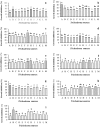Biodiversity and phylogeny of novel Trichoderma isolates from mangrove sediments and potential of biocontrol against Fusarium strains
- PMID: 31122261
- PMCID: PMC6532204
- DOI: 10.1186/s12934-019-1108-y
Biodiversity and phylogeny of novel Trichoderma isolates from mangrove sediments and potential of biocontrol against Fusarium strains
Abstract
Background: Studies carried out with novel 13 strains of Trichoderma, isolated from mangrove sediments (PE, Brazil) using morphophysiological and molecular characterization, followed evaluation of biocontrol using Fusarium strains isolated from Caatinga soil (PE, Brazil). Trichoderma strains were characterized by polyphasic taxonomic approach, and the extracted DNA was amplified with primers ITS 1 and 4, and sequenced. The biocontrol evaluation was conducted at 24 and 48 h of growth intervals by Tukey test, with a significance of 5%. Antibiosis tests were assessed in vitro by dual plate and partition plate techniques against Fusarium strains.
Results: Trichoderma molecular identification, sequences of 500 bp were amplified, deposited into GenBank, and used for phylogenetic analyses. The strains were identified as T. asperellum (10), as T. harzianum (2) and one as T. longibrachiatum. Growth rate presented an average of 0.1207 cm h-1 for Trichoderma and lower growth rate of 0.031 cm h-1 for Fusarium spp., respectively. Antibiosis tests presented the best antagonist level of efficiency for T. asperellum UCP 0149 against F. solani UCP 1395 (82.2%) and F. solani UCP 1075 (70.0%), followed by T. asperellum UCP 0319 against F. solani UCP1083 (73.4%) and T. asperellum UCP 0168 against F. solani UCP1098 (71.5%), respectively.
Conclusions: The data obtained in this study as tool for identification of novel Trichoderma strains serve as basis for development of several sustainable use for biotechnological processes. Those Trichoderma strains found promising for the management antagonistic potential and interaction could aid the conduct of biotechnological biocontrol of contaminants, and improve environmental conditions for the health of plants.
Keywords: Biocontrol; Filamentous fungi; Molecular identification.
Conflict of interest statement
The authors declare that they have no competing interests.
Figures





References
-
- Schaeffer-Novelli Y, Cintrón-Molero G, Soares MLG, De-Rosa T. Brazilian mangroves. Aquat Ecosyst Health Manag. 2000;3:561–570.
-
- Hooper DU, Chapin FS, Ewell JJ, Hector A, Inchausti P, Lavorel S, Lawton JH, Lodge DM, Loreau M, Naeem S, Schmid B, Setälä H, Symstad AJ, Vandermeer J, Wardle DA. Effects of biodiversity on ecosystem functioning: a consensus of current knowledge. Ecol Monogr. 2005;75:3–35.
-
- Gopal B, Chauhan M. Biodiversity and its conservation in the Sundarban mangrove ecosystem. Aquat Sci. 2006;68:338–354.
-
- Thatoi H, Behera BC, Mishra RR. Ecological role and biotechnological potential of mangrove fungi: a review. Mycology. 2013;4:54–71.
MeSH terms
Substances
Grants and funding
LinkOut - more resources
Full Text Sources
Miscellaneous

